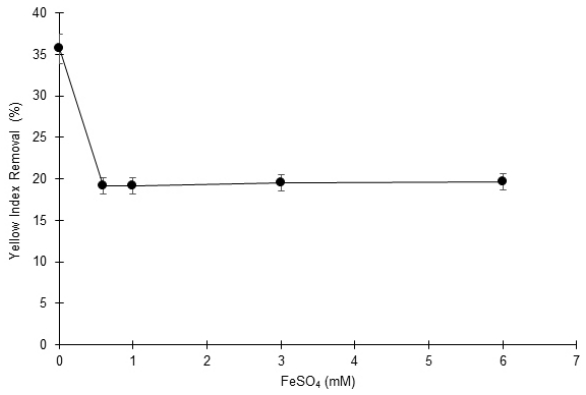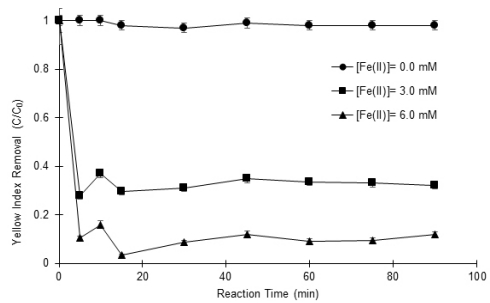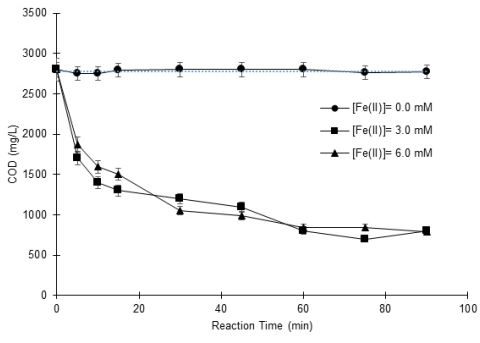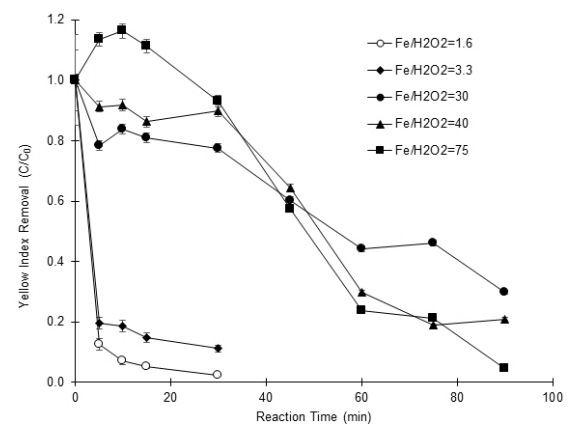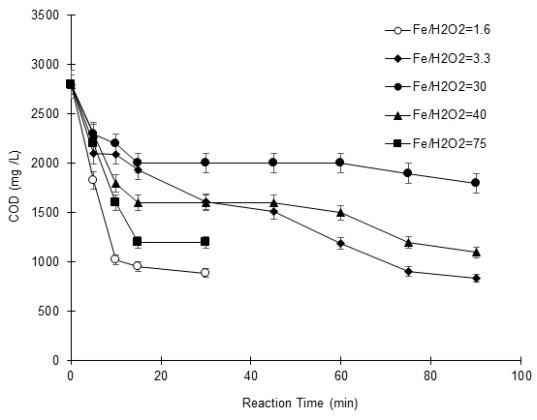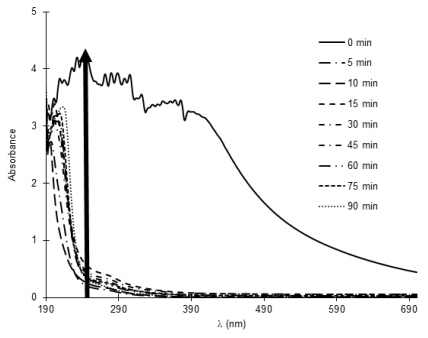1. Introduction
Municipal solid waste (MSW) management has become a complex problem worldwide. In developing countries, where a lack of proper legislation or management is common, the environmental effects created by MSWs are very important. In Mexico, the overall MSW production during 2012 was 30.7 million tons [1] and it has been estimated that up to 95% of the solid waste collected is disposed in landfills where it undergoes physical, chemical, and biological changes after being exposed to outdoor conditions [2]. When rainwater combines with the by-products of the decomposing waste, it creates a highly contaminated fluid called leachate. The composition of this leachate depends on many different variables, such as the type of waste, the age of the landfill, the water balance, the solubility of the by-products, and the leachate's interaction with the environment [3]. The only common characteristic of landfill leachate is that it has a high contamination potential [4,5].
Leachate is considered to be one of the liquid wastes with the greatest environmental impact [5], and therefore several different conventional treatment processes have been tested for their removal of undesirable components in leachate. A wide variety of physical, chemical, and biological procedures (e.g., coagulation-flocculation, air stripping, adsorption, flotation, membrane filtration, and aerobic and anaerobic biological processes) have been studied as potential treatments for landfill leachate [6,7]. However, the UK Environmental Agency has identified multistage processes as the best available technology for treating landfill leachate since 2007 [8]. Conventional activated sludge followed by classical physical-chemical processes are the standard technology used to treat stabilized leachate [7].
Recently, using advanced oxidation processes (AOPs) alone or combined with other conventional physical-chemical or biological processes have emerged as very promising alternative for effectively removing biodegradable and nonbiodegradable organic matter, mineralizing organic compounds, reducing toxicity, and enhancing the biodegradability of the effluent [3,5,9,10,11,12,13,14,15,16]. However, because the composition of leachate is so diverse, specific treatment conditions need to be identified for each effluent to achieve the best results [7,17,18].
The objective of this study was to evaluate treatments for landfill leachate using coupled, sequential coagulation-flocculation (C-F) followed by a photo-assisted Fenton reaction to remove color, chemical oxygen demand (COD), and biorefractory Ultraviolet ligh with a wavelength 254 nm (UV254) quenching substances.
2. Materials and Method
2.1. Reagents
All the reagents used in this study—sulfuric acid (H2SO4, Sigma), sodium hydroxide (NaOH, Sigma), ferrous sulfate (FeSO4, Sigma), and hydrogen peroxide (H2O2, 50% stabilized, Sigma)—were purchased as reagent grade (A.C.S.) and used as received without any further purification.
2.2. Landfill leachate sampling procedure and characterization
Leachate samples were obtained in agreement with Mexican legislation (NMX-AA-003-1980) from the Ecatepec landfill located in the State of Mexico (19°38'33.7"N 98°58'22.9"W). The Ecatepec landfill opened in 1990 and will remain operational until 2025. It receives an average of 1,600 tons of municipal waste from the municipality of Ecatepec, which is the municipality with the highest population density in Mexico. The municipal government owned and operated the landfill until 2005, when it entered into an agreement with a private company for the operation and maintenance of the landfill [19]. The samples were analyzed to determine pH; electric conductivity (EC); COD; biochemical oxygen demand (BOD); total nitrogen; ammonium nitrogen; organic nitrogen; total solids; dissolved solids; suspended solids; total volatile solids; color (yellow index) [20]; Arsenic (As); Barium (Ba); Chrome (Cr); Mercury (Hg); Lead (Pb); o-, m-, and p-cresol; and total cresol and pyridine using standard methods procedures [21].
2.3. Coagulation-flocculation (C-F) process
The C-F experiments were carried out in jar test equipment (Phipps & Bird) using five different FeSO4 concentrations (0.0, 0.6, 1.0, 3, and 6 mM). Samples were adjusted to pH = 3.0 using 0.5 N H2SO4 prior the C-F tests. The following C-F conditions were used: (ⅰ) rapid mixing at 315 rpm for 5 min, (ⅱ) low mixing at 40 rpm for 20 min, and (ⅲ) settling for 20 min. These conditions were chosen according to those reported by other similar works. Samples of the leachate were taken before and after the C-F process to analyze COD, color (yellow index), and specific ultraviolet absorbance at 254 nm (SUVA254). Assessments were carried out in triplicate under controlled conditions at room temperature (20 ± 2 ℃).
2.4. Fenton and photo-assisted Fenton reaction
Fenton (Fe/H2O2) reaction experiments were carried out in a 500 mL glass reactor with 250 mL of landfill leachate. Three iron (Fe Ⅲ) concentrations (0, 3.0, and 6.0 mmol L–1) and two hydrogen peroxide concentrations (0 and 10.0 mmol L–1) were tested. The procedure for the degradation experiments was as follows: Once the landfill leachate was added to the reactor, the pH was adjusted using H2SO4 (0.1 N) and the appropriate volume of Fe(Ⅱ) stock solution was added to achieve the desired initial concentration. The solution was stirred for 5 min using a magnetic plate. The required oxidant solution (H2O2) was added to the mixture until the desired concentration was achieved, and then a sample was analyzed. This moment was considered to be the starting point (t0) of the dark (no radiation) reaction. The reaction mixture was kept away from any light source for the entire duration of each experimental run. Samples (5 mL) were obtained every 5 min during the initial 15 min of the reaction and every 15 min during the following 90 min. The samples were then analyzed for COD, color (yellow index), and SUVA245 as described above. Once each sample was obtained, the reaction was followed until COD analysis showed no significant further variation in concentration or until the 90 min reaction time was completed.
The photo-assisted Fenton reaction was carried out in exactly in the same way. The photo-assisted experiments were performed using a UV lamp (365 nm, 5 mW). Hydrogen peroxide was added as the lamp was turned on, and this moment was considered to be the start of the degradation process. The effect of different Fe/H2O2 molar ratios (e.g., 1.6, 3.3, 30, 40, and 75) were also tested for the photo-assisted Fenton reaction to determine the effect of further changes in the molar ratio of the reagent on improving the treatment of landfill leachate. To perform these experimental runs, the proper amount of iron was added to the sample to generate the desired concentration (e.g., 0.6, 3.0, and 6.0 mmol L-1), and then the proper amount of hydrogen peroxide (e.g., 10, 12, 24, and 45 mmol L-1) was added to achieve the adequate concentration to fix the desired molar ratio.
3. Results and Discussion
3.1. Landfill leachate characterization
Table 1 shows the composition of the leachate used in the experimental setup. As shown, the high NH4-N and organic nitrogen concentration and the relatively high BOD/COD ratio seems to indicate that the landfill leachate is a young, biodegradable leachate (0.73). The ratio between ammonium nitrogen and total nitrogen support the assertion that the leachate is young and several types of organic matter remain that could be further oxidized to nitrates/nitrites or molecular nitrogen under the proper anoxic conditions [22].
Table 1. Initial composition of the landfill leachate.
| Parameter |
Value |
Parameter |
Value |
| Conductivity (μmohs cm-1) |
7,100 |
As (mg L-1) |
0.31 |
| COD (mg L-1) |
2,800 |
Ba (mg L-1) |
1.32 |
| BOD (mg L-1) |
1816 |
Cr (mg L-1) |
2.90 |
| Total N (mg L-1) |
734 |
Hg (mg L-1) |
0.01 |
| NH4-N (mg L-1) |
334 |
Pb (mg L-1) |
0.12 |
| Organic nitrogen (mg L-1) |
400 |
o-cresol (mg L-1) |
0.24 |
| Total solids (mg L-1) |
4,450 |
m-and p-cresol (mg L-1) |
0.56 |
| Dissolved solids (mg L-1) |
4,310 |
Total cresol (mg L-1) |
0.80 |
| Suspended solids (mg L-1) |
140 |
Pyridine (mg L-1) |
0.02 |
| Total volatile solids (mg L-1) |
3,350 |
pH |
8.0 |
The high concentration of total solids and the significant presence of dissolved solids compared with suspended solids can be associated with the high electric conductivity value found (7,100 µmhos cm-1), because conductivity is a measurement of the ions and dissolved solids in the sample. The presence of metals in the landfill leachate is within the range reported by the US Environmental Protection Agency (EPA) [23] and the detection of semi-volatile organic compounds in the leachate (phenol derivatives and pyridine) is in agreement with previous works related with the chemical characterization of landfill leachate plumes [17,18,24].
3.2. Coagulation-flocculation process
Figure 1 shows the color removal (yellow index) achieved using different FeSO4 concentrations for the C-F process. As shown, color removal was significantly enhanced by using the coagulant compared with the tests in which no FeSO4 was used. When the iron salt was added to the C-F process, the yellow index decreased by 45%, even at the lowest iron salt concentration tested (e.g., 0.6 mM). However, no further increase in color removal was observed when the iron salt concentration was increased up to one order of magnitude (e.g., 6.0 mM). The observed color decrease could be related with the removal of suspended solids, this color removal was achieved by the C-F process. These results are in agreement with previous reports for using C-F to treat landfill leachates using iron salts (e.g., FeCl3). Vedrenne et al. [3] found the best treatment conditions using 300 mg L-1 of ferric chloride at pH = 3.0 for removing color and COD in a leachate, which are similar to the conditions used in this study.
However, Vedrenne et al. also found a significant decrease in the COD concentration (up to c.a. 60% = 8808 mg/L approximately) when the best coagulant dose was used for the C-F process. In this study, no significant COD removal was observed during the C-F tests for any of the coagulant doses probably because of the relatively low concentration of suspended solids in the sample.
In the Table 1 shows that this concentration (e.g., 140 mg L-1) is just 3% of the total solids in the leachate and the rest are dissolved solids that the C-F process is no longer capable of treating.
3.3. Fenton and photo-assisted Fenton reactions
After the C-F process, the leachate effluent was treated using AOPs to take advantage of the dissolved iron that was already in the solution, and only the required amount of hydrogen peroxide was added to achieve the desired concentration. Figure 2 shows the yellow index behavior for the different experimental conditions tested for the Fenton reaction.
Figure 2 shows that no discoloration was achieved when hydrogen peroxide (10 mmol L-1) was used alone without adding the iron salt. The oxidative discoloration increases substantially by including the iron salt, and 68% of the color removal was achieved after 90 min of reaction for the same hydrogen peroxide concentration and 3.0 mmol L-1 of ferrous sulfate. Increasing the iron salt (e.g., 6.0 mmol L-1) generated 90% of the color removal after the same reaction time. The majority of the color removal occurred during the first 15 min of the reaction, after 75 min no further discoloration. This result was probably because of the complete oxidation of Fe(Ⅱ) to Fe(Ⅲ) and the subsequent depletion in the Fenton reaction rate.
Figure 3 shows that using the Fenton reaction after C-F removed the COD from the landfill leachate sample. As shown, 71% of the initial COD load was removed by the Fenton reaction after 90 min using both iron salt concentrations of 3.0 and 6.0 mmol L-1 with 10 mmol L-1 of hydrogen peroxide. The Figure 3 data were fitted using pseudo-first-order kinetics to generate reaction rate values for a better comparative analysis of the different processes. Table 2 shows the rate constant values that were obtained.
Table 2. Rate constant values at different ratio concentrations (Fe/H2O2).
| Experimental Conditions |
k * 10 (min-1) |
R2 |
| [Fe] = 3.0 mM, [H2O2] = 10 mM, dark (Fe/H2O2 = 3.3) |
1.14 |
0.95 |
| [Fe] = 6.0 mM, [H2O2] = 10 mM, dark (Fe/H2O2 = 1.6) |
1.15 |
0.90 |
| [Fe] = 3.0 mM, [H2O2] = 10 mM, UV (Fe/H2O2 = 3.3) |
1.45 |
0.96 |
| [Fe] = 6.0 mM, [H2O2] = 10 mM, UV (Fe/H2O2 = 1.6) |
3.80 |
0.99 |
| [Fe] = 0.6 mM, [H2O2] = 12 mM, UV (Fe/H2O2 = 30) |
1.15 |
0.92 |
| [Fe] = 0.6 mM, [H2O2] = 24 mM, UV (Fe/H2O2 = 40) |
1.50 |
0.90 |
| [Fe] = 0.6 mM, [H2O2] = 45 mM, UV (Fe/H2O2 = 75) |
1.93 |
0.91 |
3.4. Photo-assisted Fenton reaction
Using UV radiation as a driving force for the photo-assisted Fenton reaction generated interesting improvements in the color removal process, which are shown in Figure 4 for the different Fe/H2O2 molar ratios tested. It is noteworthy that the best discoloration was achieved using the lowest Fe/H2O2 molar ratio (e.g., 1.6), which removed approximately 98% of the yellow index after 30 min of reaction. Increasing the Fe/H2O2 molar ratio to 3.3 decreased the discoloration process efficiency to 90% of the yellow index after the same reaction time. Further increases in the Fe/H2O2 molar ratio produced continuing decreases in the efficiency of the discoloration process and even a slight increase in the yellow index value at the higher molar ratio value, which is probably related to interference by iron ions and/or a high hydrogen peroxide concentration.
The removal of COD in the landfill leachate by the photo-assisted Fenton reaction showed a similar trend to the color removal, which is shown in Figure 5. Once again, the highest COD removal (e.g., 68%) was achieved using the lowest Fe/H2O2 molar ration (e.g., Fe/H2O2 = 1.6), and the reduction in COD was at the same order of magnitude as the results for the Fenton reaction but was achieved in one third of the total reaction time (e.g., 30 min).
The data in Figure 5 were also fitted using pseudo-first-order kinetics to allow a more proper comparison between the two processes. Table 2 shows the results of this comparison, and the reaction rate values agree with the trends shown in Figures 3 and 5. The reaction rate value for the dark experiment (k = 0.115 min-1) is almost one third of the rate value obtained for the photo-assisted Fenton process (k = 0.380 min-1).
3.5. Specific ultraviolet absorbance (SUVA)
Specific ultraviolet absorbance-254 (SUVA254) has been associated with biorefractory organic matter, particularly materials that are known to be UV quenching (e.g., organic structures with molecular weight ranging between 500 Da-10 kDa, such as humic and fulvic acids). However, its removal efficiency has not being well documented in literature [10]. Figure 6 shows the UV-visible absorbance spectrum of the landfill leachate after using the photo-assisted Fenton reaction at different reaction time values under the best identified reaction conditions (e.g., Fe/H2O2 molar rate 1.6; photo-assisted).
Figure 6 shows that nearly complete SUVA245 absorption removal was achieved almost from the beginning of the photo-assisted reaction process. Because SUVA245 is related to a quantitative measurement of the aromatic content per unit concentration of organic carbon, the nature of Official Mexican Standard (NOM), and its fractions [25], the trend that is shown in Figure 6 means that there is an interesting decrease in the quenching potential of the leachate sample. These results suggest that the removal of humic substances in the leachate was successfully achieved by the photo-assisted Fenton process, which is in agreement with previous results [10].
4. Conclusions
Coagulation-flocculation and advanced oxidation processes were used to treat young landfill leachate in Mexico. The coagulation-flocculation demonstrated that the process effectively removed color using FeSO4. The yellow index decreased 45%, which was attributed to removal of suspended solids during the C-F process.
After the C-F treatment, the Fenton and photo-assisted Fenton processes were tested. The initial COD load was removed up to 71% by the Fenton reaction after 90 minutes of reaction. The results suggest that the photo-assisted Fenton process is the most efficient oxidation method for treating organic matter and degrading color in leachate because 68% of the initial COD load was removed but using one third of the total reaction time (30 minutes) (68% = 1904 mg/L COD removed of COD initial = 2800 mg/L).
The reaction rate value between the two processes (Fenton and photo-assisted Fenton) was fitted using pseudo-first-order kinetics and the reaction rate value for the dark experiment (k = 0.115 min-1) was found to be almost one third of the value obtained for the photo-assisted experiment (k = 0.380 min-1).
Acknowledgements
This work was partially supported by the National Council of Science and Technology, Mexico (CONACYT, grant No. CB-2011-01-168285), and by the National Science Foundation under Grant No. ⅡA-1301726. The authors would like to thank Ms. Nicole Damon (DRI) for her editorial review.
Conflict of Interest
All authors declare no conflict of interest in this review.









 DownLoad:
DownLoad: 